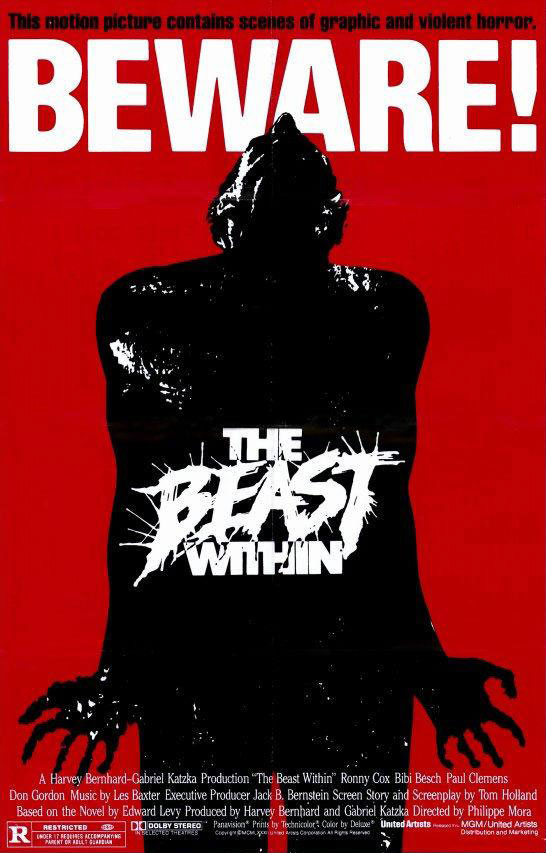In 1964, newlyweds from Jackson, Mississippi, Eli and Caroline MacCleary (Ronny Cox and Bibi Besch), are traveling through lonely Nioba County on a dark night during their honeymoon. A flat tire leaves their car beached on the side of the road, and Eli has to walk to a gas station to get a tow. Caroline stays behind, with no more than a locked car door and a dog to protect her. Out of the woods lumbers a humanoid monster that kills the dog and attacks Caroline. While she lays unconscious in the mud and dead leaves, the monster rapes her, and wanders off again before Eli and the tow truck driver return. They discover her, bruised and battered, carry her to the truck, and drive off in search of aid.
That’s the setup for The Beast Within, the 1982 horror flick from director Philippe Mora and screenwriter Tom Holland. Cut to seventeen years later, and viewers see the rape resulted in a son, Michael (Paul Clemens), who is now suffering from an unknown malady which threatens his life. The family doctor hints that it may be congenital, but tests on both Eli and Caroline show negative results. The two parents now have to confront an incident that they had hoped to forget. The key to their son’s health may lie in finding the attacker, who they don’t know is a monster, and establishing Michael’s family medical history.
Back to tiny Nioba they go, but find that the locals are no help. The first stops they make are to the local newspaper and town hall, where the editor of the paper and a judge, respectively (Logan Ramsey and Don Gordon), give them nothing to go on, while making it  clear they aren’t wanted in town. Only Sheriff Pool (L.Q. Jones) offers them a clue, telling them that the only violent crime he can recall from back when the MacCleary’s passed through was a brutal murder and dismemberment of the local mortician, one Lionel Curwin.
clear they aren’t wanted in town. Only Sheriff Pool (L.Q. Jones) offers them a clue, telling them that the only violent crime he can recall from back when the MacCleary’s passed through was a brutal murder and dismemberment of the local mortician, one Lionel Curwin.
Like many small towns, everyone is related in some way, and thus begins a conspiracy to keep the MacClearys from finding anything else that might be helpful. Meanwhile, Michael has begun having visions — sense memories from the monster that attacked his mother. Without prompting, he makes his way to Nioba. There, he begins a killing spree, murdering the extended members of the Curwin clan. He reappears during the day, ill enough to go into care at the local hospital, but he escapes at night to wreak his, and the monster’s, revenge.
The pièce de résistance of the film is a final act transformation, when Michael succumbs to the titular beast within, and becomes the true son to the monster that sired him.
Promotional material for the film latched on to this last act transformation, to the point of claiming that theaters would be supplied with barf bags for ill patrons. The effects, from a team led by Thomas R. Burman, are extensive and icky, but also a little silly. The blood and guts of the murders is more realistic and more disturbing, while the creature transformation kind of looks like ET being blown up with a bicycle pump. Still, it was innovative for its day.
As for the story, it bounces back and forth from sensible to head scratching. Apparently, Holland’s screenplay, and some footage left on the cutting room floor, did a much better job of explaining the origins of the monster and what is happening to Michael. It’s hinted strongly over the course of the film that Michael is turning into some kind of cicada/human hybrid. The exposition provided during the climax only confuses the situation more. In that way, it’s like real life, where clear answers can be hard to come by. But, this is a movie, where a lack of clarity can often be put down to flawed storytelling. That’s the case, here. The audience will get answers, but none that make sense.
The performances from the cast are mostly strong, as they were experienced professionals. Besides the names mentioned above, familiar faces of the period R.G. Armstrong, John Dennis Johnston, and Luke Askew had prominent roles. Clemens was the closest the film had to a weak spot amongst the cast. His largest flaw was a tendency to ham it up, even outside of scenes where he is killing someone. There was plenty of young talent that would go on to great things floating around Hollywood in that era, and one can’t help but think Clemens’ casting was a bit of a miss. He did give it his all, though.
There are some deep and disturbing themes in this movie, revolving around sexual assault and family secrets, that suffer through Mora’s storytelling foibles. Still, this is a nicely disgusting watch for a crisp October night with the wind blowing through the trees, and who knows what lurking in the darkness.
